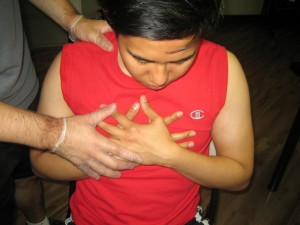Pericardial effusion is the term that describes the fluid that is collected inside the pericardial cavity. This is usually related to the inflammation of the pericardium, which is also called as the pericardial cavity. The pericardial cavity or pericardium is the double layered membrane sac or space that surrounds and protects the heart. The pericardium can only hold a limited amount of excess fluid without causing problems. The inner layer of the pericardium is the one that is near and attached to the heart. The outer layer is a strong, fibrous and elastic tissue that is somewhat thick. The space between the outer and inner layer of the pericardium can accommodate a small amount of fluid. However, if the pericardium is diseased or injured, the resulting inflammation can lead to pericardial effusion.
The material posted on this page relating to cardiac emergencies is for learning purposes only. To learn to recognize and manage major and minor cardiac emergencies sign up for a first aid and CPR class with one of our training providers.
How Do You Know if you have Pericardial effusion?
The symptoms that are produced by pericardial effusion depend on how fast the fluid is formed. The size of the effusion also influences the symptoms that you will have. You can develop a significant amount of pericardial effusion gradually, without manifesting any symptom or you may develop relatively small effusion rapidly that can compromise the functioning of your heart. The classic triad of symptoms of pericardial effusion include low blood pressure, muffled heart sounds upon auscultation and distension of the neck veins.
The symptoms may include chest pain that is usually behind the breastbone or the left side of the chest. It can worsen when you take a deep breath but may be relieved when you sit up or lie down. You may also experience the difficulty of breathing or shortness of breath, cough, low grade fever, and rapid heart rate.
When to ask for help?
The pericardium can only hold a very small amount of fluid that without causing problems. Because the inner layer of the pericardium is softer than the outer layer, fluids that may build up may cause too much pressure inward towards your heart. When this happens, the pumping chambers of the heart are unable to fill completely. This may result in the collapse of one of the chambers, a condition called cardiac tamponade. This is a life threatening condition, thus medical management as soon as possible is necessary to prevent death potential.

The symptoms vary depending on the size of the effusion as well as the time it takes to occur. First aid management, especially observable and life threatening potential may save you from cardiac tamponade. If you feel chest pain that lasts for more than a few minutes, difficulty of breathing or feeling faint, call your doctor right away. In case the person loses consciousness or is unable to breathe, call 911 and then give CPR immediately until help arrives .
Reference:
Better Health Channel. Pericarditis. Retrieved on July 5, 2014 from http://www.betterhealth.vic.gov.au/bhcv2/bhcarticles.nsf/pages/Pericarditis.

